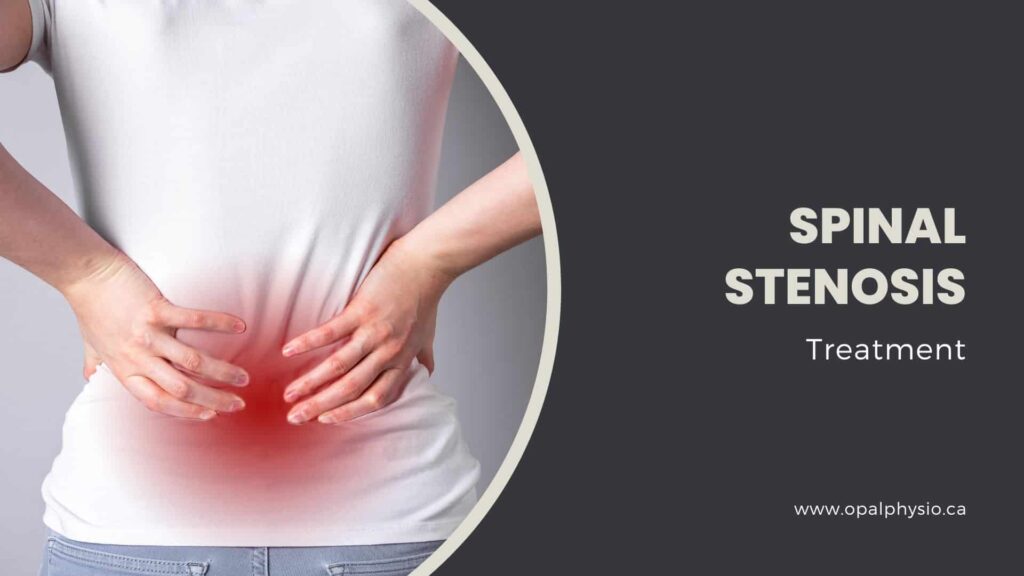Physiotherapy for Spinal Stenosis
Spinal stenosis is a narrowing of the spinal canal between the spinal vertebrae that causes compression on the spinal nerves and may lead to pain, numbness, weakness, or reduced function. It can be caused by arthritis, trauma, or congenital abnormalities. This condition is variable, and the symptoms can worsen gradually without appropriate treatment. For individuals with stenosis, symptoms may improve progressively but may not resolve completely.
Spinal stenosis can be helped through physiotherapy treatment to help relieve pain and improve function. At Opal Physiotherapy Clinic, our experienced and certified physiotherapists are committed to providing personalized care and effective treatment for patients suffering from spinal stenosis.

What is spinal stenosis?
Spinal stenosis is where the spaces within your spine narrow, placing pressure on the nerves that travel through the spine. This can cause pain, numbness, or weakness in your legs, back, neck, or arms. Spinal stenosis commonly occurs in the lumbar (lower back) and cervical (neck) regions.
Symptoms of spinal stenosis
The primary classification is based on its location and where it occurs. It is usually common in the back and neck region but can also develop in the mid-spine. The symptoms begin gradually and can progress over time.
Cervical stenosis; is a medical condition characterized by the narrowing of the spinal canal in the neck region, which can lead to spinal cord compression and nerve roots. Symptoms of cervical stenosis may include neck pain, numbness or tingling in the arms or hands, weakness, and difficulty with balance and coordination.
Lumbar stenosis – a condition in which the bones in the lower back of the spine are compressed to form a narrow passage, creating pressure in the nerves or spinal cord. Common symptoms include pain in your back, decreased range of motion in the lower back, muscle weakness, and numbness. Your symptoms can worsen with walking or standing and usually improves with sitting or leaning forward.
In severe cases, patients can have the following symptoms:
- Bowel or bladder functional loss ( incontinence ).
- Saddle anesthesia ( numbness and sensory loss in the buttocks, perineum, and groin).
- Both extremity weakness.
Common causes of spinal stenosis
General management of spinal stenosis condition
Conservative treatment is the first line of approach to managing spinal stenosis. Treatment can include epidural injections, medications and physiotherapy.
Surgery is done in severe conditions to lessen the pressure on the spinal nerves and if conservative management does not significantly relieve symptoms.

Physiotherapy treatment for spinal stenosis in Langley.
Physiotherapy treatment for spinal stenosis aims to restore normal spine function using manual therapy and exercise. This treatment can help reduce pain, improve range of motion, increase strength and improve posture.
Our physiotherapy goal is to help you continue participating in regular routines and activities. The treatment program is based on the assessment findings and your individual goals.
Our approach to spinal stenosis treatment
We understand that each case of spinal stenosis is unique, and our treatment approach is tailored to suit each patient’s specific needs. Our comprehensive treatment plan includes
Benefits of spinal stenosis physiotherapy treatment
Physiotherapy treatment can help you with the following:
- Alleviate pain and discomfort
- Improve mobility and flexibility
- Strengthen muscles that support the spine.
- Enhance the overall quality of life
- Prevent the need for surgery in some case
Post-surgical physiotherapy rehabilitation after a spinal stenosis surgery
We also offer post-surgical physiotherapy rehabilitation after a spinal stenosis surgery.
Surgery is usually considered for patients with severe pain, weakness, and reduced functional abilities like walking. Surgical procedures used to treat spinal stenosis is decompression, and the common surgical approach includes:
Physiotherapy rehabilitation after spinal stenosis surgery is extremely important for patients to recover with their mobility. It includes exercises to strengthen muscles, stretching, and other manual techniques that help patients regain their strength and ability. Post-surgical physiotherapy rehabilitation typically lasts from 6 weeks up to 3 months, depending on the severity of your condition.
Why choose us for spinal stenosis physiotherapy treatment?
- Patient-centric care: Our primary focus is on providing patient-centred care, ensuring that your needs and preferences are at the forefront of every decision. We strive to create a comfortable and welcoming environment where you can feel at ease, and our compassionate team is committed to delivering personalized care and support throughout your treatment journey.
- Collaborative approach: Our clinic fosters a collaborative approach to healthcare, working closely with other healthcare professionals, such as physicians and physiatrists, to provide a seamless and integrated treatment experience. This multidisciplinary approach ensures that all aspects of your care are coordinated and tailored to your unique needs.
- Holistic approach: We believe in taking a holistic approach to patient care. Our comprehensive treatment plans focus on alleviating pain and improving mobility and overall wellness, including emotional well-being. We work closely with you to address all aspects of your health, helping you successfully manage your condition.
- Experienced team: Our team of certified physiotherapists is highly skilled in treating spinal stenosis and other musculoskeletal condition
Book your appointment today.
Don’t let spinal stenosis hold you back from living a pain-free life. We have a team of qualified physiotherapists to help you with your spinal stenosis rehabilitation in Langley. Contact our clinic today to schedule an appointment with one of our expert physiotherapists and start your journey toward better spinal health.
